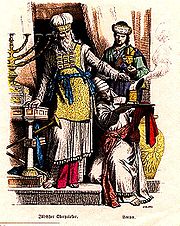
Tzitz
Encyclopedia

Tabernacle
The Tabernacle , according to the Hebrew Torah/Old Testament, was the portable dwelling place for the divine presence from the time of the Exodus from Egypt through the conquering of the land of Canaan. Built to specifications revealed by God to Moses at Mount Sinai, it accompanied the Israelites...
or the Temple in Jerusalem
Temple in Jerusalem
The Temple in Jerusalem or Holy Temple , refers to one of a series of structures which were historically located on the Temple Mount in the Old City of Jerusalem, the current site of the Dome of the Rock. Historically, these successive temples stood at this location and functioned as the centre of...
.
Etymology
The Hebrew noun tziytz (צִיץ) usually means "flower" or "blossom." as in "All flesh is grass and all the goodliness thereof is as the flower (tziytz) of the field." The term is used not just for the tiara of the priest, but also for flowers carved on the fittings of Solomon's Temple (1 Kings 6:35). The Greek Septuagint renders the word in Exodus 28:36 and elsewhere petalos (πέταλος), "blossom," from which the English "petal" derives.Hebrew Bible
The commandmentMitzvah
The primary meaning of the Hebrew word refers to precepts and commandments as commanded by God...
regarding the crown is found in :
[36] And thou shalt make a plate of pure gold, and engrave upon it, like the engravings of a signet: HOLY TO THE LORD. [37] And thou shalt put it on a thread of blue, and it shall be upon the mitre; upon the forefront of the mitre it shall be. [38] And it shall be upon Aaron's forehead, and Aaron shall bear the iniquity committed in the holy things, which the children of Israel shall hallow, even in all their holy gifts; and it shall be always upon his forehead, that they may be accepted before the LORD.
The Tzitz was a small rectangular plate of solid gold, engraved in Hebrew
Hebrew alphabet
The Hebrew alphabet , known variously by scholars as the Jewish script, square script, block script, or more historically, the Assyrian script, is used in the writing of the Hebrew language, as well as other Jewish languages, most notably Yiddish, Ladino, and Judeo-Arabic. There have been two...
letters with "HOLINESS TO THE LORD," and having holes drilled in each of the four corners through which blue cords were threaded which held the tiara onto the High Priest's priestly turban. Traditionally, it is understood that one set of cords went around the High priest's head at the base of the tiara, and the other went over the forehead, all meeting at the back of the head to hold the tiara in place.
refers to the tziytz as the "holy crown".
According to the Talmud
Talmud
The Talmud is a central text of mainstream Judaism. It takes the form of a record of rabbinic discussions pertaining to Jewish law, ethics, philosophy, customs and history....
, the wearing of the golden frontlet atoned for the sin
Sin
In religion, sin is the violation or deviation of an eternal divine law or standard. The term sin may also refer to the state of having committed such a violation. Christians believe the moral code of conduct is decreed by God In religion, sin (also called peccancy) is the violation or deviation...
of arrogance on the part of the Children of Israel (B.Zevachim 88b).
See also
- TetzavehTetzavehTetzaveh, Tetsaveh, T'tzaveh, or T'tzavveh is the 20th weekly Torah portion in the annual Jewish cycle of Torah reading and the eighth in the book of Exodus...
, 20th weekly Torah portion (parshah) - Priestly undergarments
- Priestly tunic
- Priestly sash
- Priestly turban
- Priestly robe (Judaism)
- EphodEphodAn ephod was an article of clothing, and a worship object, in ancient Israelite culture, and was closely connected with oracular practices....
- Priestly breastplate

